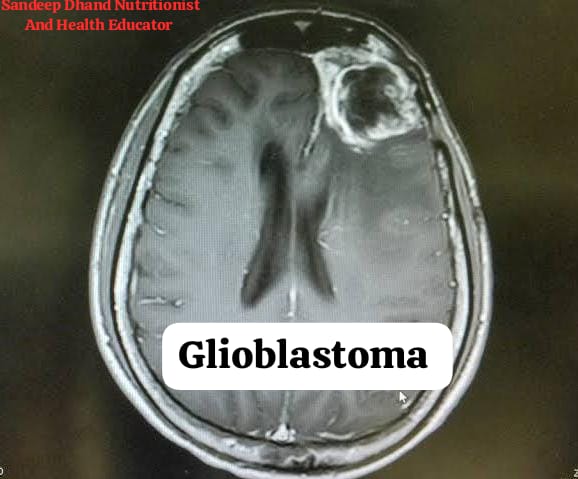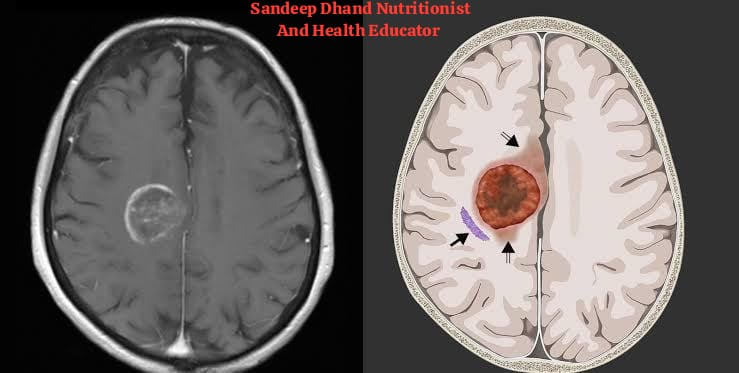Sandeep Dhand
Nutritionist And Health Educator
Glioblastoma is a type of brain cancer that begins in the glial cells. These cells help support and protect neurons (nerve cells) in the brain. It’s one of the most aggressive forms of brain cancer and can be very difficult to treat. The tumor grows quickly and often spreads to nearby tissues.
How Does Glioblastoma Develop?

Glioblastoma starts from abnormal cells in the brain. These cells grow uncontrollably, forming a tumor. The cause of glioblastoma is still not fully understood, but scientists believe it may be linked to genetic changes in brain cells. It can occur at any age, though it is more common in older adults.
Symptoms of Glioblastoma

Glioblastoma causes various symptoms that depend on where the tumor is located in the brain. Common symptoms include:
Headaches
Seizures
Memory loss
Changes in mood or personality
Difficulty speaking or understanding speech
Weakness in one part of the body
How Is Glioblastoma Diagnosed?
Doctors diagnose glioblastoma through several tests:
Imaging: MRI or CT scans are used to see the tumor and its size.
Biopsy: A small sample of the tumor may be removed and examined under a microscope to confirm if it’s cancerous.
Treatment Options for Glioblastoma
Treatment for glioblastoma often involves a combination of surgery, radiation therapy, and chemotherapy.
Surgery
The first step in treatment is often to remove as much of the tumor as possible. However, complete removal is difficult because the tumor can spread into nearby brain tissue.
Radiation Therapy
After surgery, radiation therapy is used to target any remaining cancer cells. This treatment uses high-energy rays to kill cancer cells.
Chemotherapy
Chemotherapy drugs, like temozolomide, are commonly used to treat glioblastoma. These drugs can help slow down the tumor’s growth and improve survival chances.
Challenges in Treating Glioblastoma
Glioblastoma is tough to treat because it grows so quickly and often spreads to different areas of the brain. The tumor’s cells can also become resistant to treatments, making it harder to eliminate. In addition, the brain is a delicate organ, so surgery and treatments can have risks and side effects.
Prognosis of Glioblastoma
Unfortunately, the prognosis for people with glioblastoma is generally poor. Despite treatment, the tumor often returns. The average survival time for someone with glioblastoma is around 12 to 15 months after diagnosis, although this can vary depending on several factors, such as the person’s age and overall health.
Living with Glioblastoma
Living with glioblastoma can be very challenging, both physically and emotionally. Patients may experience physical changes, cognitive problems, and emotional stress. Support from family, friends, and healthcare professionals can help individuals manage these challenges.
New Treatments and Research
There is ongoing research into better treatments for glioblastoma. Some experimental therapies include:
Immunotherapy: Using the body’s immune system to fight cancer.
Targeted Therapy: Drugs that target specific molecules involved in cancer growth.
Gene Therapy: Modifying genes to help treat the tumor.
These treatments are still in early stages but offer hope for improving outcomes in the future.
The Importance of Early Detection
Early detection of glioblastoma can sometimes lead to better treatment options, though the aggressive nature of the tumor often means it’s diagnosed at an advanced stage. Research continues to explore ways to detect glioblastoma earlier through better imaging techniques and blood tests.
Conclusion
Glioblastoma is a serious and aggressive form of brain cancer that poses many challenges in treatment. Although there is no cure, treatments like surgery, radiation, and chemotherapy can help manage the condition and improve quality of life. Ongoing research is exploring new ways to treat glioblastoma, offering hope for better outcomes in the future.
